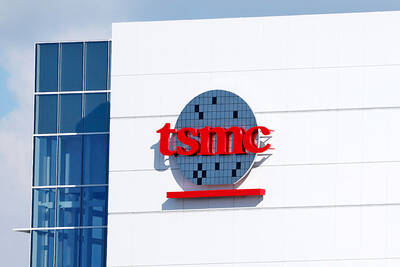US shoppers snapped up bargain basement deals on the day known as Black Friday as desperate retailers slashed prices in hopes of escaping a deepening slump.
Many shops opened before dawn and already by 8am New York’s 34th Street bustled with tourists and locals toting huge paper bags.
“Give them what they want — and hope for the best,” was how industry watcher Women’s Wear Daily summed up retailers’ strategy.

PHOTO: AFP
Clothing store Ann Taylor promised 20 percent off everything bought before noon, Lane Bryant offered “buy one get one free” and Banana Republic 40 percent off.
Frantic crowds poured through New York’s much-loved department store Macy’s, where display windows featured puppets in picture-postcard Christmas scenes.
Frieda, a marriage registrar from the Netherlands, emerged astonished at the bargains.
“I bought Levis jeans for my sons. They cost US$30 each and in Holland they cost at least US$150,” she said.
Katrina Chapman, a British accountant, said her husband had scooped up a Ralph Lauren suit for US$200 and Calvin Klein shirts for US$20 — a fraction of the price in the UK.
For the Chapmans, Macy’s was just the beginning of a day in New York’s department stores.
“We got here at 6:30am. I think we’re going to go and have breakfast and then head off to Bloomingdales,” Chapman, 32, said.
But if Macy’s was crowded, many other stores along 34th Street were not. Only five people stood waiting for Banana Republic to open.
A huge proportion of people shopping also appeared to be tourists, reflecting what economists say has been a crucial source of support for retailers.
Whether US shoppers will come to the retail economy’s rescue is still not clear.
A poll published on Friday in USA Today showed that 33 percent of consumers plan to cut spending this year, about 34 percent will spend the same as last year and only 6.9 percent plan increases.
Student Erika Pu, 20, said she was shopping, but carefully.
“I’m buying Christmas presents. You still have to do that, don’t you? But I don’t think people are going to be buying the really expensive stuff,” she said.
Her friend Carlos Ventura, a 23-year-old chef, said the economic crisis had already taken a bite out of his income and that he wouldn’t buy anything at all.
“Now I’m only cooking two or three days a week, where two months ago it was five, six days a week. I guess companies aren’t wanting to spend money on entertaining anymore,” he said.
Third quarter results leading up to Black Friday were a bloodbath for many major retailers. And some chains, including electronics goods stalwart Circuit City, have already filed for bankruptcy.
A senior executive at Best Buy, another electronics chain, put on a brave face.
“I think there’s people out and they seem to be having a great time engaging with our employees and I think there’s an optimism in the stores today,” Best Buy president Brian Dunn told NBC television.

Real estate agent and property developer JSL Construction & Development Co (愛山林) led the average compensation rankings among companies listed on the Taiwan Stock Exchange (TWSE) last year, while contract chipmaker Taiwan Semiconductor Manufacturing Co (TSMC, 台積電) finished 14th. JSL Construction paid its employees total average compensation of NT$4.78 million (US$159,701), down 13.5 percent from a year earlier, but still ahead of the most profitable listed tech giants, including TSMC, TWSE data showed. Last year, the average compensation (which includes salary, overtime, bonuses and allowances) paid by TSMC rose 21.6 percent to reach about NT$3.33 million, lifting its ranking by 10 notches

Popular vape brands such as Geek Bar might get more expensive in the US — if you can find them at all. Shipments of vapes from China to the US ground to a near halt last month from a year ago, official data showed, hit by US President Donald Trump’s tariffs and a crackdown on unauthorized e-cigarettes in the world’s biggest market for smoking alternatives. That includes Geek Bar, a brand of flavored vapes that is not authorized to sell in the US, but which had been widely available due to porous import controls. One retailer, who asked not to be named, because

SEASONAL WEAKNESS: The combined revenue of the top 10 foundries fell 5.4%, but rush orders and China’s subsidies partially offset slowing demand Taiwan Semiconductor Manufacturing Co (TSMC, 台積電) further solidified its dominance in the global wafer foundry business in the first quarter of this year, remaining far ahead of its closest rival, Samsung Electronics Co, TrendForce Corp (集邦科技) said yesterday. TSMC posted US$25.52 billion in sales in the January-to-March period, down 5 percent from the previous quarter, but its market share rose from 67.1 percent the previous quarter to 67.6 percent, TrendForce said in a report. While smartphone-related wafer shipments declined in the first quarter due to seasonal factors, solid demand for artificial intelligence (AI) and high-performance computing (HPC) devices and urgent TV-related orders

MINERAL DIPLOMACY: The Chinese commerce ministry said it approved applications for the export of rare earths in a move that could help ease US-China trade tensions Chinese Vice Premier He Lifeng (何立峰) is today to meet a US delegation for talks in the UK, Beijing announced on Saturday amid a fragile truce in the trade dispute between the two powers. He is to visit the UK from yesterday to Friday at the invitation of the British government, the Chinese Ministry of Foreign Affairs said in a statement. He and US representatives are to cochair the first meeting of the US-China economic and trade consultation mechanism, it said. US President Donald Trump on Friday announced that a new round of trade talks with China would start in London beginning today,